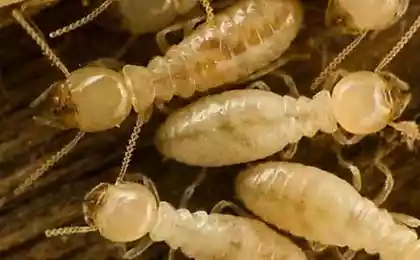276
The most dangerous diseases in history
History books are full of stories about the most terrible epidemics and diseases that wiped out many peoples (sometimes millions). This list looks at 10 of the most famous and dangerous diseases, as well as their effect on history.
typhus Typhus is one of the most dangerous diseases caused by the bacterium rickettsia. The name comes from the Greek typhos, which means "smoke, or foggy". The first reliable description of the disease appears during the Spanish siege of Moorish Granada in 1489. These records include descriptions of fever and red spots on the arms, back and chest, progressing to delirium, dead wounds and stinking rotting flesh. During the siege, the Spanish lost 3,000 men to the enemy, but another 17,000 died of typhus. Epidemics occurred throughout Europe from the 16th to 19th centuries, as well as during the English Civil War, the Thirty Years' War and the Napoleonic Wars. During the Thirty Years’ War, approximately 8 million Germans were exterminated by bubonic plague and typhus. During Napoleon's retreat from Moscow in 1812, more French soldiers died of typhus than were killed by the Russians.
Ebola virusEbola haemorrhagic fever is named after the Ebola River, where the first recognized outbreak of the fever occurred. Viruses are characterized by long strands and have a structure similar to the Marburg virus with similar symptoms of the disease. Ebola first appeared in 1976 in Zaire and remained uncertain until 1989, with an outbreak in Reston, Virginia. It has been confirmed that the dangerous disease is transmitted through body fluids, but transmission is possible through simple interaction with the patient. In the early stages, Ebola may not be very contagious. Contact with someone in the early stages may not even transmit the disease. As the disease progresses, physical fluids from diarrhea, vomiting, and bleeding pose an extreme biological hazard. Due to the lack of proper equipment and hygiene practices, large-scale epidemics occur mainly in poor, isolated areas without modern hospitals, or an educated medical staff.
malariaSome symptoms of malaria are anemia, fever, cold, and even coma or death. This disease is usually spread when a person is bitten by an Anopheles mosquito that has contracted an infection from another person. Every year there are approximately 400 million cases of malaria, killing millions of people. This disease is one of the most common infectious diseases and a serious problem. Currently, no vaccine is likely to save the patient, but development is ongoing.
Cholera.Cholera is one of the most dangerous diseases that cause serious epidemics. In its most serious form, cholera can be deadly. If not treated within three hours, the infected person may die. Signs - diarrhea, shock, bleeding from the nose, leg cramps, vomiting and dry skin. The first outbreak of cholera was in Bengal and from there spread to India, China, Indonesia and the Caspian Sea. When the pandemic finally ended in 1826, there were more than 15 million deaths in India alone. Oral rehydration therapy and antibiotics are currently treating the disease.
ospaSmallpox is believed to have started infecting humans in 10,000 BC. In England during the 18th century, the disease killed an estimated 400,000 people each year and caused many cases of blindness. The main symptom is the outbreak of small ulcers throughout the body. Other signs include vomiting, back pain, fever and headache. The earliest symptom of smallpox was found in ancient Egyptian mummies. It is believed that Egyptian traders brought the disease to India, where it remained for 2,000 years. After successful vaccination campaigns during the 19th and 20th centuries, smallpox eradication was announced in December 1979. To this day, smallpox is the only human infectious disease that has been completely eradicated.
Spanish fluThe 1918 flu pandemic (commonly referred to as the Spanish flu) spread across the globe. The epidemic was caused by an unusually dangerous and deadly H1N1 influenza virus. Historical and epidemiological data do not allow to determine the geographical origin of the virus. Most of its victims were healthy, young and adult, unlike most influenza outbreaks, which predominantly affected children, the elderly, or debilitated patients. The pandemic lasted from March 1918 to June 1920, spreading even to the Arctic and remote Pacific islands. It is estimated that between 20 and 100 million people have been killed worldwide - the approximate equivalent of one-third of Europe's population. Interestingly, Spanish flu comes from the same subtype (H1N1) as Swine flu.
Yellow fever.Symptoms of yellow fever are fever, chills, slow heartbeat, nausea, vomiting and constipation. It is estimated that the disease causes approximately 30,000 deaths each year if people are not vaccinated. A famous outbreak of yellow fever occurred in Philadelphia, Pennsylvania in 1793. The disease killed as many as 10,000 people in Philadelphia alone. Most of the population fled the city, including the president. But the mayor stayed, and life was soon restored.
tuberculosisTuberculosis caused the most widespread public concern in the 19th and early 20th centuries as a local disease of the urban poor. In 1815, one in four deaths in England was due to tuberculosis. By 1918, one in six deaths in France was still caused by the disease. In the 20th century, tuberculosis killed an estimated 100 million people. It is often a deadly disease that affects the lungs. Signs are coughing, weight loss, night sweats, and saliva with blood. Bone remains show that people as early as 7000 BC were infected with tuberculosis.
PoliomyelitisPolio is very contagious. It is a disease that affects the central nervous system and spine, sometimes leaving the victim paralyzed. Signs are headache, neck, back and abdominal pain, vomiting, fever and irritability. In 1952, an outbreak in the United States resulted in 20,000 paralyzed children and more than 3,000 dead. Since then, a vaccine has been developed and most children are protected.
Bubonic plagueBloated lymph glands, reddened and then blackened skin, heavy breathing, rotting limbs, vomiting blood and terrible pain are just some signs of bubonic plague. Pain is caused by rotting / decay of the flesh. The disease has caused more than 200 million deaths. Perhaps the most famous and horrific pandemic was in Europe in the late 1300s. The plague was known as the Black Death. The incident cut Europe's population by almost half. Bubonic plague is usually caused by the bite of an infected flea. Now, in modern times, several vaccines have been created that cure people, but it was once the most dangerous disease of all.
Source: lifeglobe.net/
typhus Typhus is one of the most dangerous diseases caused by the bacterium rickettsia. The name comes from the Greek typhos, which means "smoke, or foggy". The first reliable description of the disease appears during the Spanish siege of Moorish Granada in 1489. These records include descriptions of fever and red spots on the arms, back and chest, progressing to delirium, dead wounds and stinking rotting flesh. During the siege, the Spanish lost 3,000 men to the enemy, but another 17,000 died of typhus. Epidemics occurred throughout Europe from the 16th to 19th centuries, as well as during the English Civil War, the Thirty Years' War and the Napoleonic Wars. During the Thirty Years’ War, approximately 8 million Germans were exterminated by bubonic plague and typhus. During Napoleon's retreat from Moscow in 1812, more French soldiers died of typhus than were killed by the Russians.
Ebola virusEbola haemorrhagic fever is named after the Ebola River, where the first recognized outbreak of the fever occurred. Viruses are characterized by long strands and have a structure similar to the Marburg virus with similar symptoms of the disease. Ebola first appeared in 1976 in Zaire and remained uncertain until 1989, with an outbreak in Reston, Virginia. It has been confirmed that the dangerous disease is transmitted through body fluids, but transmission is possible through simple interaction with the patient. In the early stages, Ebola may not be very contagious. Contact with someone in the early stages may not even transmit the disease. As the disease progresses, physical fluids from diarrhea, vomiting, and bleeding pose an extreme biological hazard. Due to the lack of proper equipment and hygiene practices, large-scale epidemics occur mainly in poor, isolated areas without modern hospitals, or an educated medical staff.
malariaSome symptoms of malaria are anemia, fever, cold, and even coma or death. This disease is usually spread when a person is bitten by an Anopheles mosquito that has contracted an infection from another person. Every year there are approximately 400 million cases of malaria, killing millions of people. This disease is one of the most common infectious diseases and a serious problem. Currently, no vaccine is likely to save the patient, but development is ongoing.
Cholera.Cholera is one of the most dangerous diseases that cause serious epidemics. In its most serious form, cholera can be deadly. If not treated within three hours, the infected person may die. Signs - diarrhea, shock, bleeding from the nose, leg cramps, vomiting and dry skin. The first outbreak of cholera was in Bengal and from there spread to India, China, Indonesia and the Caspian Sea. When the pandemic finally ended in 1826, there were more than 15 million deaths in India alone. Oral rehydration therapy and antibiotics are currently treating the disease.
ospaSmallpox is believed to have started infecting humans in 10,000 BC. In England during the 18th century, the disease killed an estimated 400,000 people each year and caused many cases of blindness. The main symptom is the outbreak of small ulcers throughout the body. Other signs include vomiting, back pain, fever and headache. The earliest symptom of smallpox was found in ancient Egyptian mummies. It is believed that Egyptian traders brought the disease to India, where it remained for 2,000 years. After successful vaccination campaigns during the 19th and 20th centuries, smallpox eradication was announced in December 1979. To this day, smallpox is the only human infectious disease that has been completely eradicated.
Spanish fluThe 1918 flu pandemic (commonly referred to as the Spanish flu) spread across the globe. The epidemic was caused by an unusually dangerous and deadly H1N1 influenza virus. Historical and epidemiological data do not allow to determine the geographical origin of the virus. Most of its victims were healthy, young and adult, unlike most influenza outbreaks, which predominantly affected children, the elderly, or debilitated patients. The pandemic lasted from March 1918 to June 1920, spreading even to the Arctic and remote Pacific islands. It is estimated that between 20 and 100 million people have been killed worldwide - the approximate equivalent of one-third of Europe's population. Interestingly, Spanish flu comes from the same subtype (H1N1) as Swine flu.
Yellow fever.Symptoms of yellow fever are fever, chills, slow heartbeat, nausea, vomiting and constipation. It is estimated that the disease causes approximately 30,000 deaths each year if people are not vaccinated. A famous outbreak of yellow fever occurred in Philadelphia, Pennsylvania in 1793. The disease killed as many as 10,000 people in Philadelphia alone. Most of the population fled the city, including the president. But the mayor stayed, and life was soon restored.
tuberculosisTuberculosis caused the most widespread public concern in the 19th and early 20th centuries as a local disease of the urban poor. In 1815, one in four deaths in England was due to tuberculosis. By 1918, one in six deaths in France was still caused by the disease. In the 20th century, tuberculosis killed an estimated 100 million people. It is often a deadly disease that affects the lungs. Signs are coughing, weight loss, night sweats, and saliva with blood. Bone remains show that people as early as 7000 BC were infected with tuberculosis.
PoliomyelitisPolio is very contagious. It is a disease that affects the central nervous system and spine, sometimes leaving the victim paralyzed. Signs are headache, neck, back and abdominal pain, vomiting, fever and irritability. In 1952, an outbreak in the United States resulted in 20,000 paralyzed children and more than 3,000 dead. Since then, a vaccine has been developed and most children are protected.
Bubonic plagueBloated lymph glands, reddened and then blackened skin, heavy breathing, rotting limbs, vomiting blood and terrible pain are just some signs of bubonic plague. Pain is caused by rotting / decay of the flesh. The disease has caused more than 200 million deaths. Perhaps the most famous and horrific pandemic was in Europe in the late 1300s. The plague was known as the Black Death. The incident cut Europe's population by almost half. Bubonic plague is usually caused by the bite of an infected flea. Now, in modern times, several vaccines have been created that cure people, but it was once the most dangerous disease of all.
Source: lifeglobe.net/























